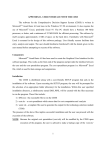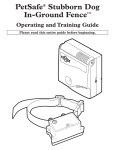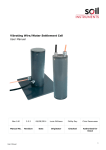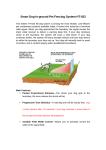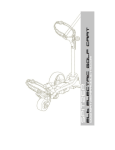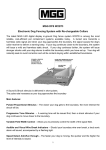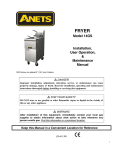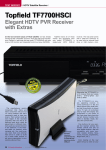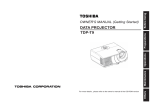Download Owner`s Guide
Transcript
Owner’s Guide PCC-100 & PCC-200 Owner’s Guide PCC-100 & PCC-200 IMPORTANT! YOUR PERIMETER PET FENCING SYSTEM COMES WITH ADDITIONAL RUBBER TIPS FOR YOUR PET’S COMFORT CONTACTS. THE COMFORT CONTACTS WILL LOSE CONDUCTIVITY OVER TIME AND NEED TO BE CHANGED TO MAINTAIN THE PERFORMANCE OF YOUR FENCING COLLAR. IF USING THE RUBBER COMFORT CONTACTS, PLEASE CHANGE RUBBER TIPS WITH EACH COLLAR BATTERY CHANGE. ADDITIONAL RUBBER TIPS CAN BE PURCHASED AT www.buyperimeter.com • Any tight collar or consistent pressure on the skin can cause a condition known as Pressure Necrosis (bed sores) which if left untreated can be severe. To help reduce the likelihood of pressure necrosis please do the following: Remove the pets training collar every 12 hours. Look for any skin irritation and discontinue product use until healed. Wash pet’s neck and collar frequently with warm soap and water. Do not attempt to wash the pet’s training collar in washing machine or dish washer. • No containment method is full proof and your Perimeter Pet Fencing System is not a substitute for responsible pet ownership and close supervision of your pet. Do not use this product when away from home. • Never use this product if you believe your pet poses any danger to people, other animals or itself. • Keep your dog safely contained and on a leash during the training process. NOTE: This equipment has been tested and found to comply with the limits for a Class B digital devise, pursuant to Part 15 of the FCC rules. These limits are designed to provide reasonable protection against harmful interference in a residential installation. This equipment generates, uses and can radiate radio frequency energy and, if not installed and used in accordance with the instructions, may cause harmful interference to radio communications. However, there is no guarantee that interference will not occur in a particular installation. If this equipment does cause harmful interference to radio or television reception, which can be determined by turning the equipment off and on, the user is encouraged to try to correct the interference by one or more of the following measures: • reorient or relocate the receiving antenna • increase the separation between the equipment and the receiver • connect equipment to an outlet or a circuit different from that to which the receiver is connected • consult the dealer or an experienced radio / TV technician for help. Caution: Changes or modifications to any component, not expressly approved by Perimeter Technologies, Inc., could void the user’s authority to operate this equipment. Owner’s Guide PCC-100 & PCC-200 Transmitter 500 ft. long fence wire AC Adapter Wire Splices Collar Boundary Flags Installation DVD Congratulations! You have purchased the most comfortable and reliable pet fencing system for your cherished family pet. Perimeter Technologies Comfort Contact™ system was designed by the industry’s most experienced team to provide years of worry-free freedom for both you and your pet. Simply follow the steps outlined in this user’s guide and your fence will be operational in no time. Should you have any difficulty along the way, help is available both by calling the Customer Care Center at 1-866-900-2007 or by talking to a local Pet Stop® Fencing Professional. www.buyperimeter.com 1 Owner’s Guide PCC-100 & PCC-200 Your new Pet Fencing System AT A GLANCE 1. Determine the layout of your fence The Comfort Contact Pet Fencing System is completely customizable to any shape of property and can be used to keep your pet away from off-limits areas such as gardens or pools. (See page 4 for sample layouts) Be sure to call your local utility companies to mark underground cables before you dig! 2. Select a transmitter location The wall-mount transmitter is your pet’s fence control center. The transmitter sends a digitally encoded radio signal through the fence wire. The transmitter needs to be located in a dry, indoors area such as a garage or utility room. 3. Layout your fence wire Always lay your fence wire on top of the ground before burying to ensure the fence is performing properly. 4. Testing your system Before burying your boundary wire. Test your fence using your pet’s training collar in multiple locations in and around the yard. 2 Owner’s Guide PCC-100 & PCC-200 Your new Pet Fencing System AT A GLANCE 5. System Adjustments Programming Options The Perimeter Ultra Comfort Contact System (PCC-200) can be programmed for up to five different stimulation levels and two different frequency settings by following the easy programming steps (see page 9 for reference). 6. Bury fence wire The fence wire that dictates your pet’s boundaries is buried 1” – 3” under the ground. You can use a flat edge spade, gas powered edger or there may be Pet Stop® Professional installation help available in your area. 7. Training your pet Training your pet to her new fence will take approximately two weeks, with most of the time spent closely watching your pet to ensure compliance to the fencing system. 3 Owner’s Guide PCC-100 & PCC-200 STEP 1 Planning your fence layout • When designing your fence layout, it is important to remember that your fence boundary is one continuous loop of wire, starting at your wall-mount transmitter, forming a boundary loop around your selected area and returning back to the transmitter. Entire Yard • You will need to allow room in your plan for 8’ – 10’ of signal area from the boundary wire. • Do not run the boundary wire within 10’ parallel of utility lines. Utility lines can create interference. Have utility lines marked prior to fence wire installation. • To maintain a consistent signal field use a gradual radius when running the wire around corners, as illustrated. Avoid hard 90 degree angles. Around Obstacles √ Back Yard Only × Separate Front & Back 4 Owner’s Guide PCC-100 & PCC-200 • Select a location to hang your system transmitter that is dry and indoors with a standard 110VAC electrical outlet nearby. A location in the garage or utility room is usually ideal. • When selecting a location keep in mind that the fence system wire will run from your transmitter to the wire boundary outdoors. This can be done through a window or by drilling a 3/8th inch hole at the base of the wall for the wire to pass through. Remove the transmitter housing cover by pressing your thumb on the bottom of the cover and lifting off. When removed, hold the base of the transmitter housing against the wall in the chosen location and mark the location of the screw holes with a pencil. Use the supplied mounting hardware and hang transmitter on the wall. Replace the transmitter housing cover by placing the cover tabs in base and pushing bottom housing down. STEP 3 Layout your fence & wire connections It is important to layout your boundary wire and test your fencing system before you bury the wire. This is a real time saver should you encounter a problem with your installation. 1. Measure the amount of distance from your wallmount transmitter to the beginning of your boundary loop at the edge of your yard. You will need to run two lengths of wire twisted together to the start of your boundary loop. Twisting the wire together cancels the radio signal and allows your pet to safely cross over. 2. Taking your two equal lengths of wire, secure two ends to 1 inch something stable and pull tout on the other ends. Twist the two pairs of wire together until there are 8 Twisted Wire – 12 twists To Transmitter per inch. It is much faster to secure two of the ends in a drill and the drill will do the twisting for you. Single Strand Yard Loop STEP 2 Selecting a transmitter location 5 Owner’s Guide PCC-100 & PCC-200 3. Starting at the end of your twisted wire, run your single strand of wire around your property as you have designed ending back again at the end of your twisted wire. Boundary Loop 4. Twist one end of your boundTo Transmitter ary loop to one end of the Twisted Wire twisted wire Splice with a wire nut. Repeat with the remaining loose ends. Using the waterproof splices, push each wire nut as far down into the gel as possible and secure lid. Check to ensure that there are only two wires for each splice used. PLEASE NOTE: Using just wire nuts or electrical tape will not keep moisture from interfering with your system’s performance. Use the supplied gel-filled splice housings. 5. Insert the other ends of your twisted wire in the wall-mount transmitter as shown. Tighten screw terminals taking care not to over tighten. AC In Ground Wire Twisted Wire 6 6. It is recommended that you ground your transmitter. Connect the ground terminal (center screw wire connection) on the transmitter to a ground rod (via electrical wire) located outside of the house with ground rod material and depth as recommended by National Electrical Code. The alternative way is to connect the ground terminal on the transmitter to the center screw on the AC outlet via electrical wire (center screw is ground). The outlet used must be grounded to be effective. An experienced pet fence dealer, tv technician or electrician can help should you have concerns regarding the proper grounding of this equipment. Owner’s Guide PCC-100 & PCC-200 STEP 4 Testing your fence operation 5. Walk back and forth over the twisted wire listening for any warning beeps. There should be none. It is important to test that your system is functioning properly before burying the boundary wire. You will be looking to ensure that the fence is activating properly at the boundary locations, as well as looking for unwanted signals in the house and other safe areas of the home. 6. Walk around the “safe” areas of the yard and house listening for any warning beeps. Again, there should be no response from the pet’s collar when further than 10’ from the boundary loop. TROUBLESHOOTING TIPS 1. Install the supplied battery in your pet’s training collar. Remove the battery cover screw cap, insert the battery and ensure that the top marked “This end up” is closest to the battery compartment opening. Replace the battery cap. 2. Ensure that the fence wires are properly inserted into the wall-mount transmitter and the adapter is plugged into the side of the transmitter and wall outlet. The transmitter display should illuminate. 3. Hold the pet’s training collar by the nylon strap as shown at approximately the height of your pet’s neck. 4. Slowly approach your outside boundary loop wire and listen carefully for the warning beeps. Should you hear the warning beeps, back up and try different parts of the boundary area ensuring that the collar is activating properly in other locations. If the collar activates too far, or too near the fence wire, adjust the signal field setting (see STEP 6). The collar will not activate at the boundary loop: • The training collar’s battery has been installed in the proper orientation and the cap has been secured. • The wall-mount transmitter has the wire that runs from the outside loop secured in the wire connectors and the transmitter is plugged in to the wall outlet. • The boundary loop is connected to the twisted wire running to your transmitter using the supplied waterproof splices and that there is only TWO ends of wire inserted into each splice. • Check to determine if your pet fence system is installed in close proximity to a neighboring system. If so, see STEP 6: System Adjustments and Programming. • Should you continue to encounter difficulties please call customer care at 1-866-900-2007 The collar activates in safe areas of the yard or home: • Check that the wire is not running close to outside utility lines and move where necessary. 7 Owner’s Guide PCC-100 & PCC-200 • Move the boundary loop away from large metal objects such as outdoor sheds or metal fences. You may encounter some obstacles that will need to be crossed during your installation. • Move the boundary wire away from the side of the house. • When crossing a concrete driveway, clean out an expansion joint with a screwdriver, push wire into the slot and cover with a clear silicone caulk. • Turn the signal strength down on the wall-mount transmitter. (See STEP 6: System Adjustments and Programming) STEP 5 Burying the fence wire After you have the fence wire positioned on the top of the ground and are satisfied that the fence is functioning properly, it is time to bury the wire. • Starting where the wire exits your home, Use a flat edge spade or gaspowered edger to cut a 1” – 3” trench at a 45 degree angle. A trench cut on an angle will keep the wire secure when put in the ground and will heal faster. • After completing the trenching around your boundary loop, insert the wire in the trench and step down to secure the wire in the ground. Do not pull the wire tight in the trench, leaving some slack for expansion due to heating and cooling. • It is helpful to water your lawn after installation and again walk over the trenched areas to further secure the wire underground. 8 • It is necessary to cut a trench in asphalt driveways with a circular saw and masonry blade. Place wire in trench and cover with asphalt sealant. • The wire can be run through PVC tubing or garden hose and left on top of the ground when crossing heavily wooded, rock areas or when crossing creeks or streams. The PVC or garden hose will not obstruct the fence radio signal. • It is not recommended that you leave the wire above ground, unprotected due to damage by weather and wild animals. Test the system again as described in step 4. This time test the fence at intervals of 10 feet and when you hear the warning beep, place one of the supplied boundary yard flags. The boundary flags will be a visual training aide for your pet during the training process. The flags will be gradually removed after the two week training period. Owner’s Guide PCC-100 & PCC-200 STEP 6 System adjustments and programming Extra Light to Extra high depending on your dog’s personality and temperament. To change the system correction levels: Adjusting the Signal Field Width PLEASE NOTE: The number displayed on your wall-mount transmitter in its normal, active state is NOT THE STRENGTH OF CORRECTION OR COLLAR OUTPUT. This number represents the signal field area. The signal field setting determines the total correction area or how far your dog’s fencing collar will activate from the fencing wire. Your system comes preset from the factory on setting 10, which is 10 total feet or 5 feet from the fence wire. You can adjust your system easily by pressing the top or bottom transmitter buttons to select a setting between 1 and 32. EXAMPLE Setting Total Signal Area Distance From Wire 10 10 ft 5 ft 14 14 ft 7 ft 20 20 ft 10 ft All Comfort Contact Pet Fencing Systems come fully programmed from the factory ready to use, however the Ultra Comfort Contact PCC-200 has two optional programming functions: Correction Level Programming (model PCC-200 only) STEP 1 – Press and hold both the top and bottom buttons, marked SCROLL and SET on the wall transmitter simultaneously for 3 seconds. The transmitter display will show “00” indicating programming mode. SCROLL SET STEP 2 – Release both transmitter buttons. Press and release the SCROLL button to select desired correction setting. The transmitter display will show corresponding number with each button push. SCROLL SET Settings 1 = Extra Light 2 = Light 3 = Medium 4 = High 5 = Progressive STEP 3 – Hold the pet fence collar receiver against the wall mount transmitter. The collar receiver light will illuminate and is ready to be programmed. Press and SCROLL SET Perimeter Pet Fencing Systems come factory preset with an automatic adjusting level of correction from low to high depending on your pet’s speed and proximity to the boundary wire. The Ultra Comfort Contact system can be programmed to any one of 5 different output levels from 9 Owner’s Guide PCC-100 & PCC-200 release the bottom button marked SET on the wall transmitter. The collar receiver light will flash the number corresponding to the level you have selected. When programming is complete the transmitter will return automatically to normal operation. Radio Frequency Programming This programming option allows the user to switch the operating frequency from 7 KHz to 10 KHz in the unlikely case of signal interference from sources such as neighboring pet fencing systems. Your system has come preset from the factory on 7 KHz where you are most likely not to encounter interference issues. To change your frequency settings: STEP 1 – Press and hold both the top and bottom buttons marked SCROLL and SET on the wall transmitter simultaneously for 6 seconds. The transmitter display will first show “00” for after three seconds, continue to press both buttons for an another 3 seconds to enter frequency mode. Either “01” or “02” will be displayed on the wall mount transmitter. SCROLL SET STEP 2 – Release both transmitter buttons. Press and release the SCROLL button to select de- 10 SCROLL SET sired frequency settings. The transmitter display will show corresponding number with each button push. Settings 01 = 7 KHz 02 = 10 KHz STEP 3 – Hold the pet fence collar receiver against the wall mount transmitter. The collar receiver light will illuminate and is ready to be programmed. Press and release the button marked SET on the wall transmitter. SCROLL SET The collar receiver light will flash the number corresponding to the level you have selected. When programming is complete the transmitter will return automatically to normal operation. Owner’s Guide PCC-100 & PCC-200 STEP 7 Training your pet LESSON 5: Off Lead Unsupervised 2 Weeks Please take your time training your dog and complete each step of the process to enjoy optimal performance from your system. If you have questions along the way, expert advise is only a call away (1-866-900-2007). LESSON 6: Flag Removal Every other day until gone The goal of fence training is to help you teach your dog to identify and respect her new fence, to make the training fair—so your dog will understand the consequences of leaving and to make the training fun—so your dog will enjoy staying and playing on your property. Completely trusting your dog with his Perimeter Fence will take place over the course of about 3 weeks. The training is a small part of the three weeks, the rest of the time is just close supervision. Time should be set aside to work with your dog for 10-15 minutes, two times per day. Both you and your dog will appreciate short, fun lessons and make the training more effective. There are six phases to the training lessons: LESSON 1: Back away from the fence! 6 Sessions • Use a calendar so you can keep track of the training process. Your dog’s behavior will tell you when it is time to proceed to the next level. • A training session includes putting the Perimeter training collar on your dog, making sure that the collar has the proper fit high on the dog’s neck and the collar is making contact with the skin. • Start every session playing with a favorite toy and plenty of praise. Make sure your dog is comfortable and having fun. • Do boundary work at locations around the entire boundary of your yard. • Always end sessions with your dog successfully avoiding the fence and with more play and praise. • If you are training more than one dog, train each dog in separate training sessions. LESSON 2: Respect the Fence 1 Session LESSON 3: Adding interesting distractions 8 Sessions LESSON 4: Off Lead With Supervision 1 Week 11 Owner’s Guide PCC-100 & PCC-200 LESSON 1 Back Away From the Fence! to anticipate the signal and retreat without your prompting. Start the first phase of training with the collar contacts covered with the supplied post covers that are included with your Perimeter Fence. This is to ensure that your dog can hear the warning tone at the boundary, but there is no chance of correction. The post covers will be removed in phase 2 of the training. Day three is successful if your dog retreats without your prompting and refuses to approach the boundary as you approach. For each successful attempt be sure to praise, praise and praise again. Put the electronic training collar on your dog and make sure the wall mount transmitter is turned on. The first lesson is to introduce your dog to the boundary and to help her understand to back away from the fence when the warning tone is heard. With your dog on a lead, casually walk to the boundary. When the dog reaches the signal field and hears the warning beep, immediately spin around and briskly jog back into the yard. The dog will feel the tug and run after you. Praise enthusiastically. On days two and three repeat the same lesson in different part of the yard. As the training sessions of the next three days progress, you’ll see that your dog will start 12 LESSON 2 Respect the Fence Although your dog is learning fast and avoiding the boundary, he will forget or attempt to break the rules with an interesting distraction beyond your yard. To prevent this, your dog must experience what happens if the fence boundaries are not respected. For the next lesson, you will need to remove the post covers from the training collar contacts. With your dog still on a lead, walk to the boundary with your dog. Have a helper walk on the outside of the fence area. The helper should ignore your dog and never coax the dog out of the fenced area. Your dog will most likely forget earlier lessons and attempt to leave the safe area. The moment your dog reacts to the fence correction, immediately retreat to the safe part of the yard and lavish your dog with praise. Please note, it is very important that your helper not stop, look back or acknowledge the dog in any way. Continue this lesson at a number of different areas around the boundary. Owner’s Guide PCC-100 & PCC-200 Should your dog not appear to have felt the collar correction, check to ensure the collar is making contact with the skin. It may be necessary to use one of the longer metal contacts provided for dogs with a dense coat. LESSON 3 Distractions If your dog is avoiding the boundary at multiple locations around your boundary, you are ready to add more tempting distractions. Remember, never pull or coax your dog into the boundary area. This lesson teaches your dog that he must resist all temptations to leave the yard. You can’t assume that if your dog won’t chase a ball out of the yard, He won’t chase a bicycle. Or favorite neighbor. Your training has been successful at this point if your dog has resisted the urge to cross the boundary on lead with any distraction you can dream up. LESSON 4 Off Lead With Supervision After several sessions of distractions, your dog should be ready for off lead play. You must stay in the yard for off lead training. The more your dog stays on the property for the first month, the less chance of your dog ever attempting to leave the area. Continue to supervise and play with your dog outside for a period of one week. Should your dog bolt out of the property for any reason during this phase, retrace your training your last training steps with distractions with your dog on a leash. LESSON 5 Off Lead Unsupervised When your dog resists all manner of distractions, both on and off the lead, he can be left unattended in the yard. Keep a close eye on your dog for two weeks from inside the house. This freedom should be brief at first and the amount of time increased gradually. Before and after each unsupervised session, you must continue the play and praise routine to reinforce that the yard is a happy, fun and safe place to be. 13 Owner’s Guide PCC-100 & PCC-200 LESSON 6 Removing the Flags After two weeks of successful containment, you can begin removing the flags. Start by removing every other flag, every other day until all of the flags are gone. The leads, trainers, flags and the electronic training collar are all clues for your dog to learn the boundaries. They are all removed gradually except the electronic training collar. It’s essential that you observe whether you’re off lead, unsupervised dog still avoids and retreats from the unmarked boundary. If your dog’s response is anything but immediate retrace your steps through the training process. Thank you for choosing Perimeter Pet Fencing Systems. 14 Owner’s Guide PCC-100 & PCC-200 TRAINING AND INSTALLATION NOTES: 15 Owner’s Guide PCC-100 & PCC-200 TRAINING AND INSTALLATION NOTES: 16 LIMITED LIFETIME WARRANTY Call Customer Care First. We Can Help. 1-866-900-2007 Perimeter Technologies®, Inc. warrants that its products to the original retail purchaser will be free from defects in material and workmanship, under normal use, for a period of one year from the date of the original retail purchase at no cost. Shipping to repair center not included. This coverage does not include accidental damage or misuse. After one year from date of original consumer purchase, Perimeter will, at our option repair, replace or upgrade the defective component at a fixed rate based on the component, for the life of the original owner. Owner must provide proof of purchase. Cost of shipping is not covered under the limited lifetime warranty. Some shipping charges may apply. Perimeter Technologies offers a hassle-free replacement program. Simply call 1-866900-2007 and let us help you with your problem. Please do not return this product to your retailer. Perimeter Technologies, Inc. 1-866-900-2007 www.buyperimeter.com ©2008 Perimeter Technologies, Inc. All rights reserved. Our products are covered by U.S. Patent Numbers: 5,460,124 - 5,682,839 - 6,296,776 13010019 Rev. A 0208





















